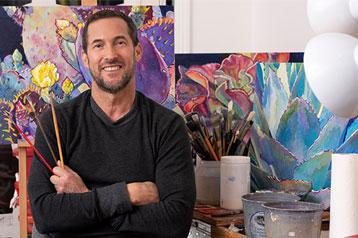


Mark Lee Goldberg’s accessible, vibrant, and emotional “impressionistic realism” paintings are studies in light and color. For this self-taught artist, painting “full time” had been a life-long dream. Goldberg worked as a film and videotape editor for a number of years but in ’93 took a year-long sabbatical to “find his voice” as a painter. This resulted in “GARY’S GREENHOUSE AND GARDEN-1994;” a collection of 18 botanical “portraits.” Much to his surprise the exhibit sold out; Goldberg then reevaluated career goals, continuing to paint full time.
Goldberg’s approach is rooted in the conventions of photo-realism (Spanish Fountain #2, Yellow Orchids) yet more importantly these early works represent his desire to honor the memory of his 11 year partner, Gary Gleason, by portraying the plants Gary nurtured while battling AIDS. The subsequent hot, harsh, cruel summer is evoked in The Broken Pot’s jagged shards on a blindingly white wooden deck; the seedlings prematurely yanked from their soil, jarringly angled, doomed.
The subsequent series, “MEN IN SUNLIGHT-1995″ marks the pinnacle of Goldberg’s photorealistic stage while themes of self-reflection, isolation, depression, and anger are explored. (Self-Portrait With Goatee, Michael, Empty Bench, Broken Pot #2”
“BOTANICAL GARDENS-1996” vacillates stylistically and thematically between the photo-realistic, somber Cranky Child In Greenhouse, Child Posing In Greenhouse, and Century Plant, to the relatively uplifting Brooklyn Conservatory and Windy Lilies.
BAR PEOPLE-1997, primarily influenced by the Impressionists, represents a sharp diversion from sunlit botanicals. (Degas’ Melancholy homaged in Melancholy; Manet’s Le Bar aux Folies-Bergere inspired Blue Daiquiri and Margarita Bartender.) Girl Shooting Pool #1 and the allegory, Alter Ego, continue exploring themes of isolation, grief, and detachment, while stylistically inching away from Realism and more towards Impressionism. Edward Hopper’s themes of urban isolation and somber studies of light and shadow are also in evidence, as seen in Shirtless Bartender Yellow Awnings. Color and light, however, are celebrated in works such as Flower Corridor, Fancy Tulips, and Canal Boat #1. This period represents the dual influence of both Impressionism and Realism. (see Amsterdam Canal #2, Bouquet-Red/Yellow Tulips. Liquor Bottles.)
The next significant shift in style and subject follows a workshop in “Impression Color Theory.” BEACHBALLS, BEACHCHAIRS, & BEACH UMBRELLAS- 1999-2001 employs such techniques as the of layering colors, glazes, and an astute depiction of color temperature as he explores the relationship of light and shadow on fabric, water, and garishly colored plastic. For the first time style BECOMES content.
The provocative CONFRONTAL NUDITY- 2000-04 is Goldberg’s most powerful series to date, comprised of over twenty nude portraits. Each model directly confronts the viewer as if to say, “Yeah, I’m naked, so what? I don’t have a problem with it; maybe you do.” With this series, Goldberg stylistically inches back towards Realism, yet with him takes the Impressionists tools and techniques.
In 2003 Goldberg returned to his original career of TV editing and put the paintbrushes down for nearly 15 years, with just a few paintings in that time. After years of kind encouragement from friends and family, Goldberg started a new series; SUCCULENTS shown in 2017 and additional works in 2019. These go back to the familiar plants in sunlight subject matter, but compositionally are quite intimate; nearly abstract. These emphasis color to depict light and shadow, warm and cold.
The recent mixed media pieces are comprised of small squares of color that are wired together, creating an intricate 3-D abstract composition with lush swirling colors that, at a slight distance, blend together so each square becomes it’s own color statement.
The imaginative viewer will perhaps also see an image in the entire composition when viewed from a distance. Goldberg has observed the viewer become very engaged and interactive, wanting to view the work very close up and at various distances, sometimes squinting their eyes or looking through a camera viewfinder in hopes of discovering the realistic image. And, of course, there are always many questions.
Goldberg finds this extremely rewarding to see people engage with and/or become moved by his artwork. Often people have said they want to step into the painting.